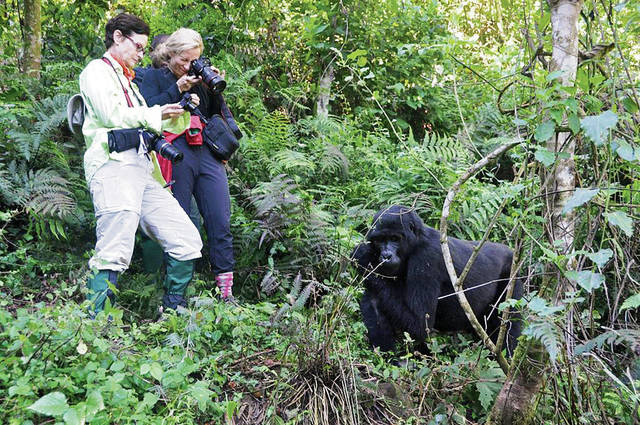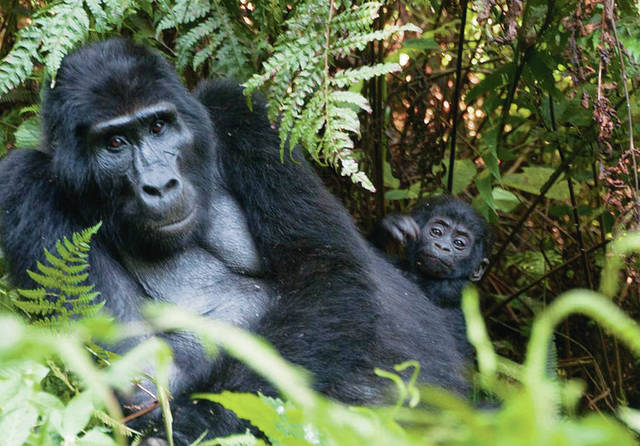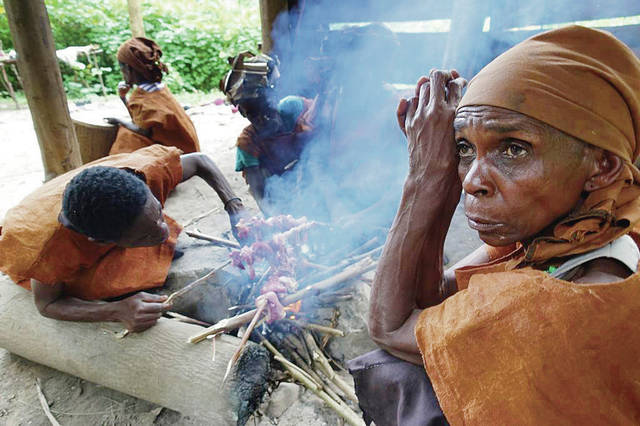Uganda’s mountain gorillas come far closer than we expect

COURTESY FIVESTARSTOUNDERTHESTARS.COM
Our gorilla trek into the wilds of Uganda’s Bwindi National Impenetrable Forest brought us face-to-face with the 15-member Rushegura group.

COURTESY FIVESTARSTOUNDERTHESTARS.COM
A mother and baby of the 15-member Rushegura group.

COURTESY FIVESTARSTOUNDERTHESTARS.COM
Our gorilla trek into the wilds of Uganda’s Bwindi National Impenetrable Forest began in the village of Nukoma, in the early morning hours. By the time we returned, the village church was filled with worshippers dressed in their Sunday best.

COURTESY FIVESTARSTOUNDERTHESTARS.COM
Some of the people of the small community of Batwa.




BWINDI IMPENETRABLE NATIONAL FOREST, Uganda >>
The gorillas ignore us so completely that if one hadn’t brushed against my leg on her way to a new perch, we might have been invisible.
We’re trying to keep the proscribed distance of 20 feet, but the family of 15 gorillas ignores the theoretical boundary. When a female suddenly moves out of the thick green bush, there’s no time to scramble out of the way. Our ranger tells me to stand still until she passes, then beckons me out of the way lest she reverse course.
Even without that simple brush, our encounter with the gorillas is far closer than we had imagined. So is their total disregard for our presence. We might share 98.4 percent DNA with these linebacker-sized cousins, but by most appearances, they couldn’t have cared less.
The opportunity to spend an hour in the wild with one of the world’s estimated 35 gorilla families drew about 40,000 trekkers last year to Uganda, home to more than 50 percent of the mountain gorilla population. Since 2007, the country’s total number of annual tourists has almost doubled to 1.3 million, according to Stephen Asiimwe, CEO of the Uganda Tourist Board. Some 18 international airlines now fly to the international airport at Entebbe, including Emirates, Qatar, Brussels and KLM.
IF YOU GO
Don't miss out on what's happening!
Stay in touch with breaking news, as it happens, conveniently in your email inbox. It's FREE!
>> Bwindi National Forest: More than half the world’s remaining mountain gorilla families are in Uganda, concentrated in two parks, Bwindi Impenetrable National Forest and the Virunga Mountains, which shares a border with Rwanda. The mountains also spill into the Democratic Republic of Congo. Most visitors go to Uganda or Rwanda. (Congo visitors typically travel from Rwanda.) In all areas, gorilla trekking permits are limited and date-specific. They must be arranged in advance. Uganda permits cost $600 per person per day; they also offer some low-season discounts. Rwanda recently increased its permit fee to $1,500 per person per day. The Congo charges the least, $450.
>> Uganda: Our trip to Bwindi National Forest was arranged by the London-based firm Africa Travel Resource, which arranged our flights to/from the international airport in Entebbe to Bwindi National Forest, our hotels in Bwindi and Entebbe, plus an ongoing flight to South Africa. Coincidentally, ATR is owned by the same company as Mahogany Springs Lodge, which we had specifically requested. Lodge rates in low season (March-May, October-November) start at $240 per person per night, double occupancy, and include three meals, water in the rooms and wine or beer with dinner. High season (December-February, June-September) rates start at $287 per person. Locally, the firm Trek East Africa has been recommended. Click here to learn more about the highly regarded Bwindi Community Hospital.
>> Rwanda: Rwanda’s big advantage is proximity; the gorilla region is a two-hour drive over paved roads from the capital of Kigali. One highly recommended agent is Phoebe Weinberg of Greatways Travel.
Almost 40 years have passed since the exile of Uganda’s infamously brutal “Last King of Scotland,” the dictator Idi Amin, and almost 15 years since his death. While the 30-plus-year government of President Yoweri Museveni has been marred by questionable election practices and human rights infringements, the U.S. government writes “Under Museveni, Uganda has experienced relative political stability, democratic progress, and economic growth” and considers it a “reliable, stable partner.”
No argument from us. Our previous gorilla-viewing attempt — to see the lowland gorillas on the border between Cameroon and the Central African Republic some years ago — earned only distant sightings after a grueling, multi-day drive over mud roads. In Uganda, our four-day visit was filled with friendly locals, stunning landscapes, comfortable lodgings and surprisingly good food — and left us with a yen to return.
Gorilla-viewing tourism launched in the late 1990s to create alternative employment to poaching. In Uganda, 20 percent of every permit fee — or $180 per visitor — goes to the local community. Jobs as hotel staff, drivers, rangers, guides and porters all go to locals.
Despite some persistent poaching and habitat loss, the plan seems to be working: Between 1989 and 2011, the number of individual gorillas grew from about 620 to about 880, according to Bas Huijbregts, African species manager for the World Wildlife Fund’s Wildlife Conservation Program. Data from the most recent census, in 2015-16, is still being analyzed, he says.
Gorilla-zone governments get their part: Uganda charges $600 per person per day for the highly coveted, date-specific permits. Rwanda recently doubled its fee from $750 to $1,500, with $150 per permit now going to the local community. The De- mocratic Republic of Congo charges only $450, but instability in the region makes it the least popular of the three, and the U.S. State Department warns Americans against visiting.
Getting to Bwindi National Forest requires a five-to-six-hour drive on dirt roads. We’ve opted for the alternative: a 90-minute flight from Entebbe. A driver picks us up for a 60-minute drive to the hotel, through villages with mud-brick houses, through the occasional herd of long-horned cattle.
Our upscale lodge, Mahogany Springs, sits just a mile from the park office, on a hillside with a massive mahogany tree. The campus of six cottages fits its location: comfortable without being ostentatious.
A gorilla trek requires an early start: By 8 a.m., all visitors holding this day’s permits have gathered at the park headquarters for orientation and assignment, a maximum of eight visitors per group. In the rainy season of May, crowds are less than full force; there are only five in our group.
Technology sets the direction. Since dawn, Bwindi’s park rangers have radioed with the trackers who watch over each gorilla family to gauge their locations and deter poachers. Their reports establish launch points for the day.
My septuagenarian husband and I have requested a gentle trek due to his cranky knees; the 30-something New Yorker, Taryn, and her boyfriend, woozy from a long car drive, have the same request. But there are no promises about how long the search will take; some treks last the better part of the day. Despite the hefty price of a permit, there is no guarantee we’ll see gorillas at all.
We drive a few miles from park headquarters to the village of Nukoma. Omax, our ranger guide, is in the lead, followed by a rifle-bearing guard, a college intern — talk about an assignment! — and a trio of porters we’ve hired in the village as a way of supporting the local economy.
The mountain path runs next to the village church. Past the last windowless houses, their bricks cemented with mud; beyond a goat resting on a platform, above the reach of marauding red ants; through a shady banana grove; by an open hut where a handful of men carve wood into gorilla- shaped souvenirs. Buffering the village is a lush field of tea leaves, a cash crop with a bitter taste that creates a natural fence between humans and the great apes.
Even on the clear part of the path, the climb is steep. With thighs burning and sea-level lungs wheezing, we head slowly, slowly up the mountain.
We’re lucky. Just a few steps beyond the reach of the village boom box, the juveniles come into view. Omax watches as they clamber up a thatch of ficus trees, then jump from limb to limb. The gorilla family has traveled over the mountain ridge and down the steep incline far more quickly than our trackers, who lag a few miles behind. For now, the apes seem set in place.
Omax signals to drop the packs with the porters. We trudge through the low brush to begin our viewing in a clearing beneath the trees.
There, seemingly oblivious, sits the No. 2 male, Kalembezi, munching away on figgy fruits thrown down from the branches by the younger, lighter juveniles. Just up the slope, a female emerges through the green, a baby clinging to her back. Another with baby aboard shimmies down the trunk of the sturdy ficus. And finally, the silverback lumbers through the jungle and into view.
In Cameroon, we had only a glimpse of the gorillas at a far distance. Here, we’re within a few feet, close enough to hear the odd belch of a satisfied diner and the flatulence caused by an herbaceous diet.
Seeing the apes as human is no anthropomorphic leap. Palms are padded, giving way to four flexible fingers and a thumb used to break branches and brush off the figs. One of the babies keeps falling from its mother’s back. Another keeps wandering off into a low patch of ferns, hauled back by his mother just before he moves beyond her reach.
Kalembezi is messy, his mossy fur dotted with straw. As the family’s No. 2, he keeps a slight distance from the others. His job is understudy, a back-up in case Kabukojo, the silver-backed leader, gives way to age or illness. But Kabukojo is himself less than middle-aged in gorilla terms; Kalembezi could be in for a 20-year wait.
Despite the proximity, we feel perfectly safe, and in fact, dangerous encounters are almost unheard of, according to Asiimwe. Visitors aren’t allowed contact with a troop until rangers and scientists have spent two to three years habituating a family, and because the two species can share diseases, humans aren’t allowed to visit if they are sick.
That’s not to say that the gorillas are always cheerful. Just this summer, in Rwanda, a silverback charged a tourist group in a mock attack — typical behavior when gorillas feel crowded.
Other travelers have posted videos of a touchingly close encounter, when gorillas came into a camp; a recent Rwanda visitor has told us of a mother gorilla pulling her husband back from her wandering babies.
Fellow trekker Melissa Cameron of San Francisco has had this experience once before, during a previous visit to Uganda in 2006. “The gorillas were very much the same. They were gorgeous,” she recalls. Her first visit, though, was more arduous, with guides whacking through the bush on a hike that lasted almost three hours before her group found the gorillas.
On that visit, the encounter took place in a thickly jungled area. This time, we had a small clearing. So while the rest of us were snapping away through long lenses, Cameron put her cellphone aside and sat down. “The best times are when you put the cameras down. That’s when the real magic happens … . Every time I crouched down to the ground, the gorillas would approach me and come sit down near me. At one point, one was literally 3 inches away.”
The gorillas are always in charge. To ensure their comfort, viewings are limited to an hour. The apes don’t need a Timex to know when time is up. A fellow lodge guest told of the silverback that stood on his haunches, beating his breast to signal that her group’s time was up. In our case, the dismissal is less dramatic — but no less punctual. After almost exactly an hour together, the silverback quite literally turns his back on us, and the troop moves away.




